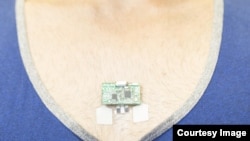There's plenty of wearable tech out there.
The Fitbit can monitor your steps, the Omron will give you a constant view of your blood pressure, and Hexoskin's biometric shirts will monitor your heart and breathing rates as well as the calories you've burned.
And all of this information can be downloaded or sent right to your smartphone.
A more complete health picture
Now, nanoengineers and electrical engineers from the UC San Diego Center for Wearable Sensors have advanced the technology to the point where now a wearable device can also measure some chemical levels inside the body.
In this case, the scientists have created a device that can measure the body's levels of lactic acid.
They are calling it the Chem-Phys patch and describe how it works in the May 23 issue of Nature Communications.
Lactate, or lactic acid, is the chemical that builds up in your muscles during strenuous exercise; it's the 'burn' that people feel when lifting weights.
It is also an important marker in gauging heart health.
Lactic acid, however, isn't particularly good for us and can be deadly if too much of it builds up in the body.
So, the scientists created a device smaller than a credit card that is placed directly on the skin.
It has two sensors; one is a tiny EKG which monitors the electrical activity of the heart.
The other measures lactate levels and can send that information to your smartphone via bluetooth.
The lactate-heart connection
Lactate levels and the heart are connected because the body doesn't produce lactic acid unless it has run out of oxygen to keep the muscles working.
If the heart isn't doing its job so well, high lactate levels are one way to tell.
The scientists who created it also think it could have great applications for athletes who are trying to improve their performance.
Tracking the relationship among heart levels, oxygen levels and lactate production may be a good way to track an athlete's fitness and look for areas of improvement.
The scientists aren't done, however. They are working to put other chemical sensors on the patch - ones that could read magnesium and potassium levels.
Patrick Mercier at the UC San Diego Jacobs School of Engineering said, "One of the overarching goals of our research is to build a wearable tricorder-like device that can measure simultaneously a whole suite of chemical, physical and electrophysiological signals continuously throughout the day,"
And those signals could be available almost instantly to a doctor or coach via phone.









